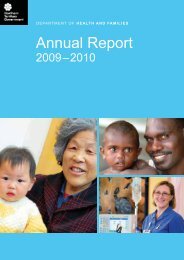PCD Strategy Evaluation 2007.pdf - NT Health Digital Library ...
PCD Strategy Evaluation 2007.pdf - NT Health Digital Library ...
PCD Strategy Evaluation 2007.pdf - NT Health Digital Library ...
Create successful ePaper yourself
Turn your PDF publications into a flip-book with our unique Google optimized e-Paper software.
The Community Services Division – Alcohol and other Drugs,Information – the <strong>Health</strong> Gains Unit and PCIS,Acute Care – hospitals, dialysis facilities and visiting specialists,Corporate Management Services Division – educational activities such as orientationprograms, and theOffice of Aboriginal <strong>Health</strong> – Family and Social Policy.There are over 150 remote health clinics in the <strong>NT</strong> and there are a number of different modelsand organisations managing remote health clinics. Clinics situated in areas covered by theKatherine West and Sunrise <strong>Health</strong> Boards are staffed by employees of the <strong>Health</strong> Boards and actin accordance <strong>Health</strong> Board policies. Clinics that are funded through PHCAP are staffed with<strong>NT</strong>DH&CS staff, but are under the control of ATSI Regional <strong>Health</strong> Boards. Staff of <strong>NT</strong>DH&CSclinics that are not part of the health zones are funded by the <strong>NT</strong>DH&CS and respond to<strong>NT</strong>DH&CS policies. Staff in clinics run by Aboriginal Community Controlled <strong>Health</strong> Centres act inresponse to their own policies. While there is some co-ordination across all of these bodies andsome shared resources, such as the CARPA guidelines, there is a lack of consistency due to thesefactors.Chronic Disease Programs in <strong>NT</strong>DH&CS clinics and community healthIn 2001, Clarke attempted to record what chronic disease activities were taking place in<strong>NT</strong>DH&CS clinics. She reported that residents of Darwin and Alice Springs could access a range ofservices for prevention, early detection and best practice management. A number of these wereoffered through the non-government sector: GPs, Specialist Physicians, Lifestyle interventionsthrough nutrition counselling, regular incentives and opportunities for physical activity, supportgroups and counselling for those with chronic diseases to engage in self- management practices.Clarke found that a number of health zones appeared to have less access to chronic diseaseservices including: Northern Barkly, Pitjantjatjara, Darwin (Belyuen), Top End West and SouthEast Arnhem (62) . She also found preventive services were scant for physical activity and nutrition,and tobacco cessation programs only occurred spasmodically. Screening programs did occur inmost communities, but lacked targeted men‟s health programs. The area of best practicemanagement showed widespread gaps in the self-care management and rehabilitation focusedprograms (62) . Clarke recommended: highly prioritising primary prevention especially in the areaof community interventions to improve nutrition, increase exercise, and decrease smoking. Shealso recommended improving the coverage and quality of best practice management. A strongfocus of the next phase should be in professional development for remote area staff on how toChapter 3: Progress Against <strong>PCD</strong>S Objectives – <strong>Evaluation</strong> of the <strong>NT</strong> Preventable Chronic Disease <strong>Strategy</strong> 2007 49
















